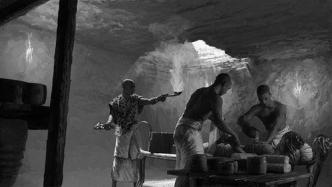

Egyptians embalming a body in a crypt (art view). Image credit: Nikola Nevenov
Chemical analysis of the contents of a labeled jar found in a 2,500-year-old "embalming workshop" has uncovered plant and animal extracts used to make ancient Egyptian mummies, scientists said. Some of the plants even came from Southeast Asia thousands of kilometers away. The research results were published in Nature on February 1.
Previously, knowledge of the embalming process came mainly from two sources—historical documents and chemical analyzes of the mummy itself. But linking these chains of information has proven difficult, says Salima Ikram, an archaeologist and mummification expert at the American University in Cairo. "You may know the name of something, but you don't know what it is, other than hieroglyphs suggesting it's an oil or a resin."
This situation did not change until 2016 when an underground embalming workshop was discovered in Saqqara. Saqqara is an ancient Egyptian necropolis that has been in use since 2900 BC or earlier. The author of the article stated that the site also has a burial chamber, and the deceased probably had a higher social status. Archaeologists have found dozens of embalmed ceramic containers in Saqqara workshops from 664 to 525 BC, many of which are marked with their ingredients and uses.
"This is the first time I've seen a labeled jar," Ikram said.
To determine the exact composition of the mixture in the container, an Egyptian-German team carried out an analysis using gas chromatography-mass spectrometry at the Giza National Research Center laboratory. It turned out that the jars contained substances associated with mummification, including extracts from juniper, cypress and cedar trees that grow in the Eastern Mediterranean. The team also found bitumen from the Dead Sea, as well as animal fat and beeswax from the local area.
The researchers also discovered two surprising components: a resin called elemi from canary trees in the rainforests of Asia and Africa; and a resin called dammar from the tropical forests of southern India, Sri Lanka and Southeast Asia Sala tree.
"Egypt was resource-poor in many ways, so a lot of resinous material was procured or traded from far away," says archaeological scientist Carl Heron of the British Museum in London, UK.
Ancient trade networks connected India and Southeast Asia to the Mediterranean region. But Ikram said it's unclear whether ancient Egyptian embalmers were specifically looking for these specific ingredients or stumbled upon them through trial and error.
The authors say that ancient Egyptian embalmers had an in-depth knowledge of the properties of raw materials. The jars contained complex mixtures, which in some cases were heated or distilled. Many of the resins have antimicrobial properties, and a bowl of animal fat reads "Pleasant Smell".
" Their understanding of these substances is incredible ," says study co-author Maxime Rageot, a biomolecular archaeologist at the University of Tübingen.
Rageot notes that chemical studies of the mummies have shown that embalming methods have become more sophisticated over time. One open question is how the ancient Egyptians developed specific embalming procedures and why they chose certain ingredients over other ingredients.
Related paper information: https://doi.org/10.1038/d41586-022-04400-1
(Original title "The Secret of Mummy Making Revealed")